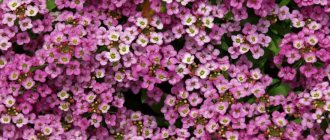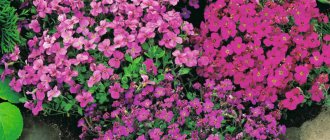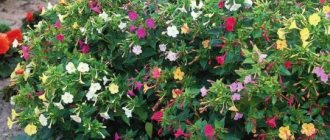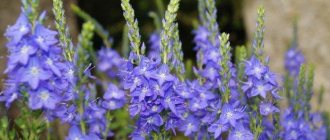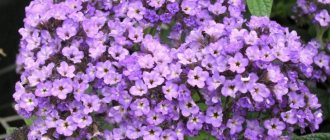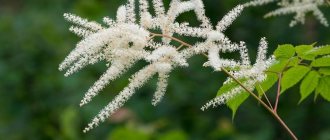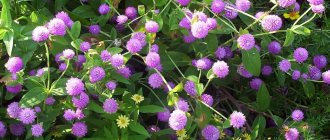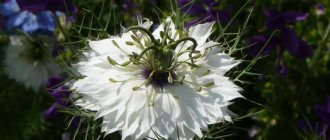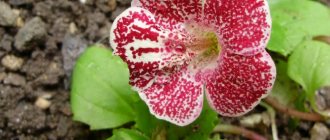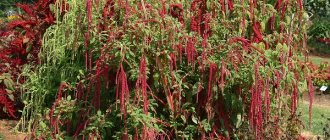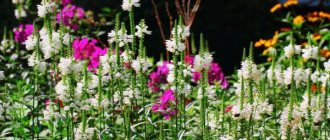Alyssum, also called sea lobularia, or alyssum, is a genus that is part of the Brassica family (formerly Cruciferous). This genus includes approximately 100 different species. In nature, such plants can be found in Asia, North Africa and Europe. The word "alissum" itself is a Latinization of the Greek word "alisson", where "a" is translated as "without" (negation), and "lyssa" means "dog rabies". There is an assumption that this plant was used in ancient times to treat rabies in dogs. Gardeners began cultivating alyssum relatively recently, but it is becoming more and more popular every year. This is due to the fact that the flower is very easy to care for, and it also has a very strong honey aroma.
Description and features of alyssum
Alyssum (Alyssum) has dense, semi-lignified shoots, they are straight, ascending or creeping. The flower forms a dense subshrub from 10 cm to a meter in height and up to 1.5 in width. The leaves are thick, petiolate, oblong, oval, covered with silvery down. Reaches 15-40 cm, the buds are formed from four petals arranged crosswise and combined into inflorescences.
The flowers are presented in small clusters of snow-white, golden, pink, lilac, and yellow colors. They bloom in May, bloom until late autumn, excellent honey plants. The honey aroma of certain varieties of alyssum spreads over several meters.
The fruit is a flat pod with seeds that remain viable for three years. The rhizome is superficial with adventitious roots.
Forming a fluffy carpet, alyssum is used in the landscape design of parks, squares, for the design of flower beds, rock gardens, and ridges. They are also used to decorate hanging flowerpots, pots, and boxes.
Alyssum contains alkaloids, organic acids, flavonoids and has medicinal properties. It is used as a decoction for colds, an infusion for facial care, and dried parts in aromatherapy.
general information
Alyssum is a beautiful herbaceous plant with lush and vigorous flowering. In colloquial speech it is often called a “mason” for its habit of settling in the mountains and on rocks. In its natural environment it grows in temperate and subtropical latitudes.
Small herbaceous alyssum bushes grow to a maximum of half a meter. But they are very branched and thick, so they seem voluminous and create a luxurious, lush carpet. The fleshy leaves are densely covered with silvery hairs, which give them a bluish tint.
Alyssums have voluminous racemose inflorescences, which attract gardeners. In nature, yellow, white or pink shades are more common in all their diversity. The center of the flower resembles a tiny bright eye, and the honey aroma attracts bees.
Photo: commons.wikimedia.org
Types and varieties of alyssum
Types and varieties vary in height and color palette.
| View | Description | Varieties | Flowers |
| Rocky | 28-30 cm high. Leaves do not fall even in winter. The flowers are paniculate, bloom in April-May, and fade early. | Citrinum | Lemon yellow. |
| Plenum | Terry, golden yellow. | ||
| Dudley Neville | Yellow-brown. | ||
| Gold painting | They bloom after two years, golden yellow. | ||
| Aphrodite | Purple. | ||
| Compactnum | Small, fragrant, yellow. | ||
| Nautical | In the middle zone it is distributed as an annual, up to 25 cm high. The stems form compact rosettes. Blooms from May until frost. | Schneeshturm | Large, white. |
| Purple Haze | Purple. | ||
| Esther Bonnet Deep Rose | Small, bright, lilac-pink. | ||
| Violet Konigin | Purple. | ||
| Apricot | Pink-salmon. | ||
| Ampelny | Popular for pots, with highly branching and long stems. The inflorescences create a huge ball. Blooms from July to October. | Snow | White, blooming like a carpet. |
| Snow Princess | Small, snow-white, very fragrant. | ||
| Gmelina (mountain) | The branches are creeping and ascending. The leaves are pubescent. The raceme-shaped inflorescences bloom in May and August. | Honey dessert | Small, yellow. |
| golden wave | Bright yellow. |
Climatic conditions for alyssum
Annuals are characterized by long flowering, and perennials are resistant to low temperatures. The climate for the unpretentious alyssum is both warm and harsh.
There are species that adapt well to the northern regions; alyssum seedlings are planted there. In warm climates, the seeds are sown directly into the ground and the plant delights with its blooming appearance more than once a season.
Answers to frequently asked questions
How can you stimulate seeds for further growth?
You can increase the rate of seed germination using conventional growth stimulants or boric/succinic acid.
Why don't the seeds germinate?
The first reason why alyssum seeds may not germinate is a lack of light. If this is all right, then pay attention to the temperature in the room.
Why are seeds soaked?
Soaking the seeds is necessary to awaken the growth processes in them. Alyssum seeds do not require pre-soaking, as they have a thin seed coat and germinate easily.
How to harden Alyssum seedlings?
For hardening, you need to move the container with the first shoots outside for several hours, and every day you need to increase the time spent on the street.
What to do if Lobularia seedlings do not grow?
It is necessary to move the container to another place, add light and heat.
Methods for planting alissum
Alyssum is planted with seedlings and seeds. The seedlings are pre-prepared in a greenhouse, with the onset of sunny and warm weather they are placed in a flower bed; the second method is to immediately sow the seeds.
Growing alyssum from seeds
When grown from seeds, alyssum will bloom in 1.5 months.
Another option is to sow them in November. Thus, the process of stratification will take place and the spring seedlings will be healthier. But in cold climates they can die.
The soil for seeds is dug up, cleared of weeds, loosened, and watered if necessary. You can plant them in a permanent place or first in a separate bed. Place the seed material in the grooves. Moisten and cover with film. Weed regularly. Shoots appear after a week at a temperature of +16 °C. They are thinned out to a distance of more than 10 cm and fertilized with mineral mixtures.
In November, seeds are still sown before winter, in 1-2 cm grooves. Sand is poured, dry seed is placed, and sprinkled on top. The next season shoots appear. If it's cold, they are covered with film. Then, when the seedlings grow, they place them in the selected area.
Growing alyssum with seedlings
In cold areas, seedlings are prepared as early as mid-March. Seeds are sown in containers, soil is purchased in a specialized store or pots with peat. Choose dishes with drainage holes. They are scattered and left in the light. Cover with film and ventilate regularly. Create bright lighting, temperature +10...+15 °C, moderate humidity, water. When the first true leaf appears, it is fed. They dive when 2-3 leaves are formed. For hardening, the seedlings are regularly taken out into the air for a few minutes.
Planting alyssum in open ground
Planting and care in open ground is distinguished by the choice of location, timely watering, and fertilizing. Seedlings or seeds are planted in the spring, from April to June, and the area should be sunny, without stagnant moisture, the soil should be neutral, slightly alkaline.
The flower loves to grow next to a rocky path or decorative tiles. Too nutritious soil produces dense greenery and few flowers.
What time to plant alyssum
The month of planting is chosen depending on the region, usually in May-June. Plant a flower in a flowerbed only when the frosts have passed and the soil has warmed up.
Landing Features
When growing in open ground, take into account the type of flower in order to dig the appropriate hole for the development of the root system. Sand is added to dense soil. The distance between plants is maintained at 25-40 cm.
What plants does it go with?
Alyssum can be combined with all types of low-growing or ground cover plants that do not create shade and require the same conditions for growth. An ampelous culture is often used to plant dwarf varieties of conifers.
Varieties with different colors create multi-colored borders
Included in mixborders with dwarf carnations, phlox, heuchera, geranium, and forget-me-nots. The main thing is that they are combined in the color palette, emphasizing each other.
Important! Unsuitable partners for alyssum are aggressor plants with a creeping root system
Loosestrife, May lily of the valley, and small periwinkle are capable of displacing the hanging crop from the site
Alyssum care
Water the flower abundantly, especially in hot weather, but it does not like stagnant moisture. When the soil dries out by 2-3 cm, then this should be done. Remove weeds and regularly loosen the soil. They also use an automatic watering system.
The perennial is fertilized with a solution of urea and Agricola (1 tbsp per 10 liters). Before flowering, it needs complex mixtures, twice a season is enough. Annuals prefer frequent feeding up to four times. They are applied at the root in the morning.
Pruning alyssum
In the spring, old peduncles, dried leaves, and weak, diseased stems are cut off from perennial specimens. After summer flowering, shoots are cut to 50-80 mm, forming a beautiful and compact bush.
Alyssum after flowering
When the alyssum has finished blooming, it is prepared for wintering. The annual plant is removed, and the perennial plant is cut by 2/3 and the soil around is loosened.
Collecting seeds
In September and early October, seeds are collected from the flower. For collection choose dry, windless weather. They usually spread a blanket under the bush and rub the inflorescences with their hands. The seed material is dried and stored in paper bags or fabric bags until the next season.
Wintering perennial
Before the onset of cold weather, pruning is not done. Alyssum may die if the temperature is -15 °C, so the flower is covered with dry leaves, mulch is placed under the bushes, and when snow appears, it is covered with it. This is how the plant survives the winter.
Alyssum propagation
The flower is propagated by cuttings, dividing the bush, seeds, and it is also capable of self-sowing.
The first method is not very popular; cut cuttings of an adult flower are placed in a container of water. Then they are rooted in a container with soil.
When dividing a bush, it is dug up, divided into parts and planted at a distance of 30 cm.
The seed method was discussed above.
Diseases and pests of alyssum
The flower can be susceptible to fungal diseases, and it is also sometimes attacked by pests.
| Pest or disease | Manifestations on leaves | Remedies |
| Late blight (brown rot) | Many brown-gray spots. | They are treated with copper oxychloride and fungicides - Ordan, Tanox. |
| Viral mosaic | In mosaic spots, the shoots weaken. | Infected bushes are destroyed and the soil is changed. |
| Downy mildew (downy mildew) | Small red, purple or brown spots. | Treated with Oksikhom, Ordan, Bordeaux mixture. |
| Powdery mildew | White coating on all parts of the plant. | Spray with Topaz. |
| Cruciferous flea beetle | Black bugs with a green tint are gnawing. | Use Actellik, vinegar essence (1 tbsp and 10 liters of water). |
| Mealybug | White insects and plaque on the plant. | Treated with Fitoverm, Aktara. |
| White turnip | Sluggish, wilted shoots, pale green insects visible. | Entobacterin is used. |
| Cabbage moth | They dry out and growth stops. | Spray with Lepidocide. |
| Caterpillars | Destroy leaf blades and shoots. | Use a solution of tobacco with soap, chamomile, Kinmiks. |
Growing difficulties
Bulbous flowers for the garden and indoor plants
Despite the ease of care, difficulties may arise in growing it:
- Alyssium does not bloom. The main reasons why alyssum does not bloom are plant diseases. This can be late blight and brown rot. A white coating begins to form on them. Diseases occur due to excessive pruning or high levels of nitrogen fertilizers. Diseased specimens are dug up, the roots are washed in a pink solution of potassium permanganate and planted in another place.
- Alyssium does not grow. The flower may not grow due to the presence of pests on it. The main pests are cruciferous flea beetles and cabbage moths. To combat them, it is necessary to treat the plant with special preparations. “Aktara”, “Aktellik”, “Fitoverm” are suitable.
Alyssium is a beautiful plant that goes well with other flowers, whether in the garden or flower bed. It can be combined with viola, roses, irises, and tulips. It is easy to care for, so novice gardeners should definitely pay attention to this flower.
